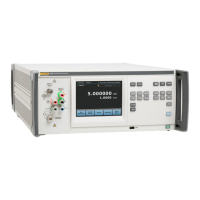5790B
Operators Manual
4-32
Note
The /AF option includes a high-quality, rugged, 0.91 meter (3 foot)
Type “N” cable assembly and a 50 MHz, 0 dBm spot calibration to
measure the 50 MHz reference output of RF power meters. The
cable is marked with the same serial number as the product. The
spot calibration is done with the cable attached and the
specifications only apply when that cable is attached. Push the
50 MHz Cable Correction softkey to enable the cable corrections.
The specifications are only applicable for the 700 mV range at
amplitudes of 223.607 mV (0 dBm nominal)
±
5 % and from 48 MHz
to 52 MHz. For measuring the accuracy of a 50 MHz reference
output of an RF power meter, turn on the power reference output on
the UUT and monitor the measurement on the Product.
5. For normal wideband operation, vary the source from 10 Hz to 30 MHz
(Option 5790B/3) or 50 MHz (Option 5790B/5) while recording the amplitude
error relative to the stored 1 kHz reference. The error can be shown in ppm,
percent, voltage, or ratio as the input frequency is swept through its range.
Note
You can use the same technique to check frequency flatness with
the main input.
6. In addition to RF voltage, the wideband menu has an RF Power function that
toggles the on-screen measurement between equivalent power in watts (W)
and decibel-milliwatts (dBm).
Techniques for Reducing Transfer Errors
In making ac-dc transfers for the purpose of determining absolute ac voltage,
errors can come from dc reversal, loading (both cable induced and instrument
input), thermal emfs, changes in mechanical contact, spurious ground currents in
the signal leads, and EMI.
Knowing more about these errors can help reduce the amount of time you spend
experimenting and debugging to get the best possible results. Once you are
confident that error sources are minimized, a good practice is to take three
measurements. That way, if one measurement is faulty, it stands out.
DC Reversal
In measurement mode, the Product cancels potential dc reversal errors by
chopping its internal dc reference into a low-frequency square wave. In transfer
mode, it is up to you to correct for dc reversal to meet specifications. Apply one
polarity of dc to the transfer standard input and push the Set Reference softkey,
then reverse the input polarity and push the Average Reference softkey. In this
way you establish a reference that consists of the average of both polarities of
the dc input.

